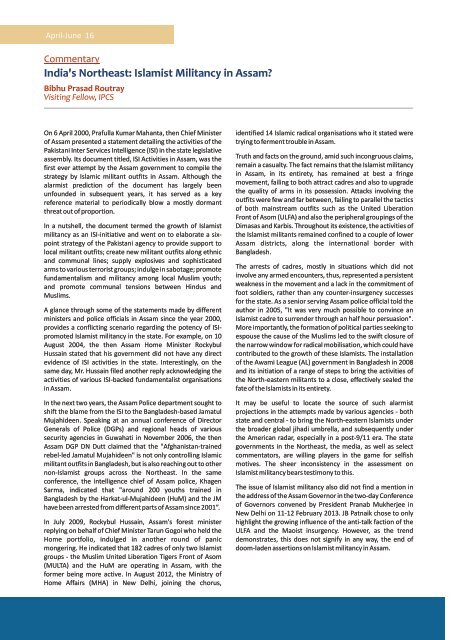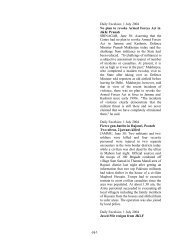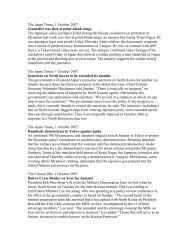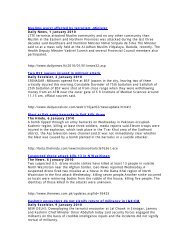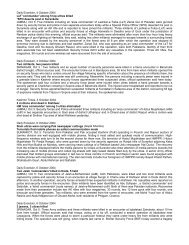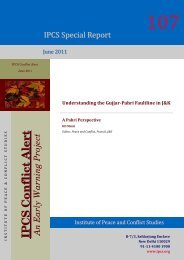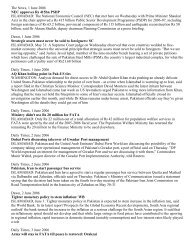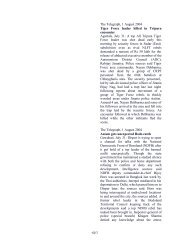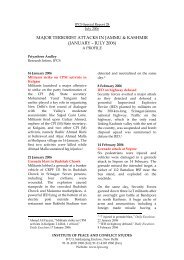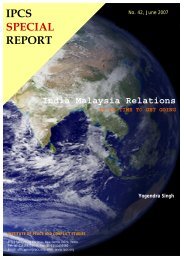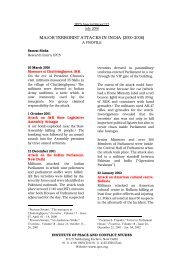April-June 2013 - Institute of Peace and Conflict Studies
April-June 2013 - Institute of Peace and Conflict Studies
April-June 2013 - Institute of Peace and Conflict Studies
You also want an ePaper? Increase the reach of your titles
YUMPU automatically turns print PDFs into web optimized ePapers that Google loves.
<strong>April</strong>-<strong>June</strong> 16<br />
Commentary<br />
India's Northeast: Islamist Militancy in Assam?<br />
Bibhu Prasad Routray<br />
Visiting Fellow, IPCS<br />
On 6 <strong>April</strong> 2000, Prafulla Kumar Mahanta, then Chief Minister<br />
<strong>of</strong> Assam presented a statement detailing the activities <strong>of</strong> the<br />
Pakistani Inter Services Intelligence (ISI) in the state legislative<br />
assembly. Its document titled, ISI Activities in Assam, was the<br />
first ever attempt by the Assam government to compile the<br />
strategy by Islamic militant outfits in Assam. Although the<br />
alarmist prediction <strong>of</strong> the document has largely been<br />
unfounded in subsequent years, it has served as a key<br />
reference material to periodically blow a mostly dormant<br />
threat out <strong>of</strong> proportion.<br />
In a nutshell, the document termed the growth <strong>of</strong> Islamist<br />
militancy as an ISI-initiative <strong>and</strong> went on to elaborate a sixpoint<br />
strategy <strong>of</strong> the Pakistani agency to provide support to<br />
local militant outfits; create new militant outfits along ethnic<br />
<strong>and</strong> communal lines; supply explosives <strong>and</strong> sophisticated<br />
arms to various terrorist groups; indulge in sabotage; promote<br />
fundamentalism <strong>and</strong> militancy among local Muslim youth;<br />
<strong>and</strong> promote communal tensions between Hindus <strong>and</strong><br />
Muslims.<br />
A glance through some <strong>of</strong> the statements made by different<br />
ministers <strong>and</strong> police <strong>of</strong>ficials in Assam since the year 2000,<br />
provides a conflicting scenario regarding the potency <strong>of</strong> ISIpromoted<br />
Islamist militancy in the state. For example, on 10<br />
August 2004, the then Assam Home Minister Rockybul<br />
Hussain stated that his government did not have any direct<br />
evidence <strong>of</strong> ISI activities in the state. Interestingly, on the<br />
same day, Mr. Hussain filed another reply acknowledging the<br />
activities <strong>of</strong> various ISI-backed fundamentalist organisations<br />
in Assam.<br />
In the next two years, the Assam Police department sought to<br />
shift the blame from the ISI to the Bangladesh-based Jamatul<br />
Mujahideen. Speaking at an annual conference <strong>of</strong> Director<br />
Generals <strong>of</strong> Police (DGPs) <strong>and</strong> regional heads <strong>of</strong> various<br />
security agencies in Guwahati in November 2006, the then<br />
Assam DGP DN Dutt claimed that the "Afghanistan-trained<br />
rebel-led Jamatul Mujahideen" is not only controlling Islamic<br />
militant outfits in Bangladesh, but is also reaching out to other<br />
non-Islamist groups across the Northeast. In the same<br />
conference, the intelligence chief <strong>of</strong> Assam police, Khagen<br />
Sarma, indicated that "around 200 youths trained in<br />
Bangladesh by the Harkat-ul-Mujahideen (HuM) <strong>and</strong> the JM<br />
have been arrested from different parts <strong>of</strong> Assam since 2001”.<br />
In July 2009, Rockybul Hussain, Assam's forest minister<br />
replying on behalf <strong>of</strong> Chief Minister Tarun Gogoi who held the<br />
Home portfolio, indulged in another round <strong>of</strong> panic<br />
mongering. He indicated that 182 cadres <strong>of</strong> only two Islamist<br />
groups - the Muslim United Liberation Tigers Front <strong>of</strong> Asom<br />
(MULTA) <strong>and</strong> the HuM are operating in Assam, with the<br />
former being more active. In August 2012, the Ministry <strong>of</strong><br />
Home Affairs (MHA) in New Delhi, joining the chorus,<br />
identified 14 Islamic radical organisations who it stated were<br />
trying to ferment trouble in Assam.<br />
Truth <strong>and</strong> facts on the ground, amid such incongruous claims,<br />
remain a casualty. The fact remains that the Islamist militancy<br />
in Assam, in its entirety, has remained at best a fringe<br />
movement, failing to both attract cadres <strong>and</strong> also to upgrade<br />
the quality <strong>of</strong> arms in its possession. Attacks involving the<br />
outfits were few <strong>and</strong> far between, failing to parallel the tactics<br />
<strong>of</strong> both mainstream outfits such as the United Liberation<br />
Front <strong>of</strong> Asom (ULFA) <strong>and</strong> also the peripheral groupings <strong>of</strong> the<br />
Dimasas <strong>and</strong> Karbis. Throughout its existence, the activities <strong>of</strong><br />
the Islamist militants remained confined to a couple <strong>of</strong> lower<br />
Assam districts, along the international border with<br />
Bangladesh.<br />
The arrests <strong>of</strong> cadres, mostly in situations which did not<br />
involve any armed encounters, thus, represented a persistent<br />
weakness in the movement <strong>and</strong> a lack in the commitment <strong>of</strong><br />
foot soldiers, rather than any counter-insurgency successes<br />
for the state. As a senior serving Assam police <strong>of</strong>ficial told the<br />
author in 2005, "It was very much possible to convince an<br />
Islamist cadre to surrender through an half hour persuasion".<br />
More importantly, the formation <strong>of</strong> political parties seeking to<br />
espouse the cause <strong>of</strong> the Muslims led to the swift closure <strong>of</strong><br />
the narrow window for radical mobilisation, which could have<br />
contributed to the growth <strong>of</strong> these Islamists. The installation<br />
<strong>of</strong> the Awami League (AL) government in Bangladesh in 2008<br />
<strong>and</strong> its initiation <strong>of</strong> a range <strong>of</strong> steps to bring the activities <strong>of</strong><br />
the North-eastern militants to a close, effectively sealed the<br />
fate <strong>of</strong> the Islamists in its entirety.<br />
It may be useful to locate the source <strong>of</strong> such alarmist<br />
projections in the attempts made by various agencies - both<br />
state <strong>and</strong> central - to bring the North-eastern Islamists under<br />
the broader global jihadi umbrella, <strong>and</strong> subsequently under<br />
the American radar, especially in a post-9/11 era. The state<br />
governments in the Northeast, the media, as well as select<br />
commentators, are willing players in the game for selfish<br />
motives. The sheer inconsistency in the assessment on<br />
Islamist militancy bears testimony to this.<br />
The issue <strong>of</strong> Islamist militancy also did not find a mention in<br />
the address <strong>of</strong> the Assam Governor in the two-day Conference<br />
<strong>of</strong> Governors convened by President Pranab Mukherjee in<br />
New Delhi on 11-12 February <strong>2013</strong>. JB Patnaik chose to only<br />
highlight the growing influence <strong>of</strong> the anti-talk faction <strong>of</strong> the<br />
ULFA <strong>and</strong> the Maoist insurgency. However, as the trend<br />
demonstrates, this does not signify in any way, the end <strong>of</strong><br />
doom-laden assertions on Islamist militancy in Assam.


